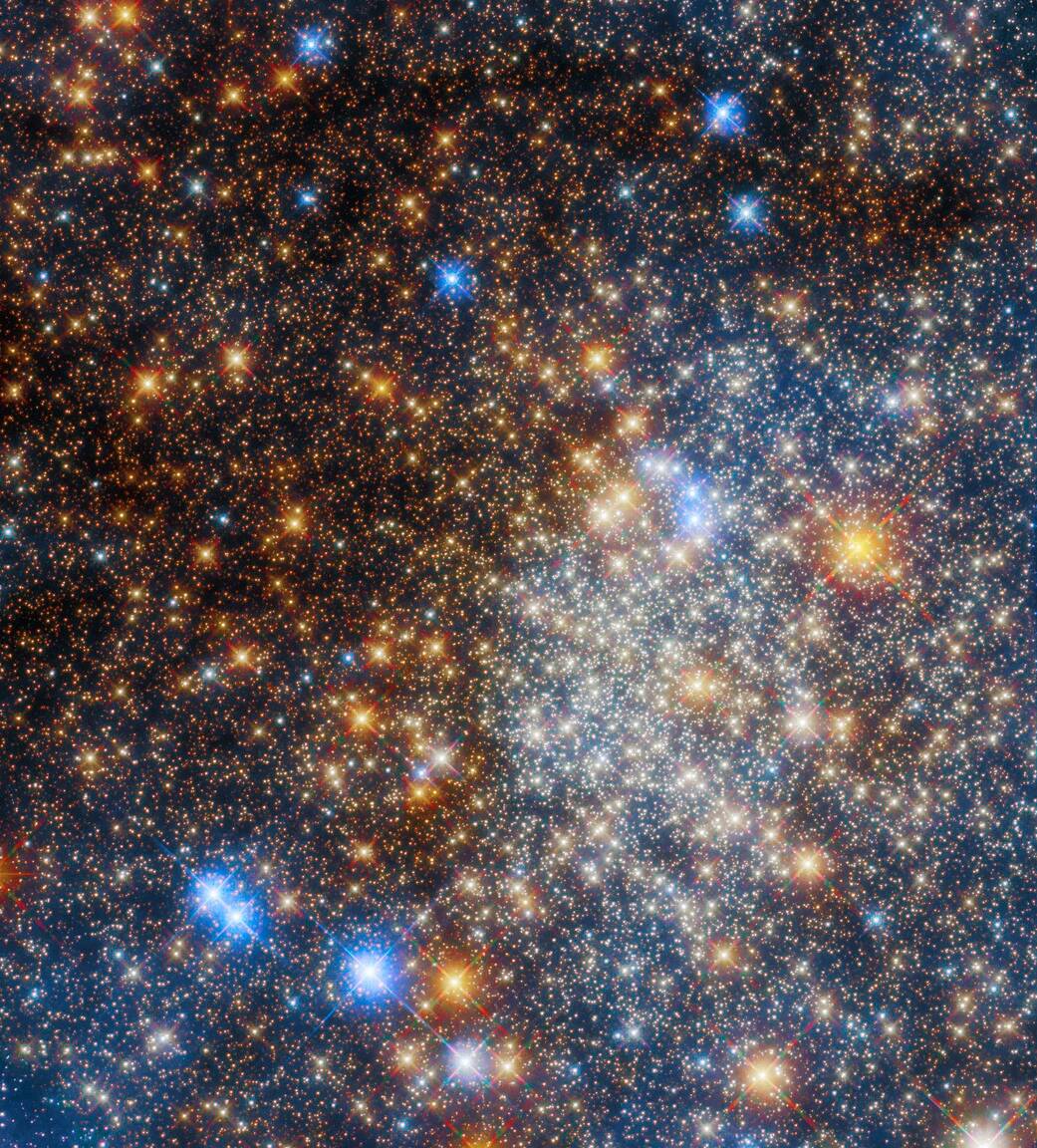This colorful image of the globular star cluster Terzan 12 is a spectacular example of how dust in space affects starlight coming from background objects.
A globular star cluster is a conglomeration of stars, arranged in a spheroidal shape. Stars in globular clusters are bound together by gravity, with a higher concentration of stars towards the center. The Milky Way has about 150 ancient globular clusters at its outskirts. These clusters orbit around the galactic center, but far above and below the pancake-flat plane of our galaxy, like bees buzzing around a hive.
The location of this globular cluster, deep in the Milky Way in the constellation Sagittarius, means that it is shrouded in gas and dust which absorb and alter the starlight emanating from Terzan 12. The cluster is about 15,000 light-years from Earth. This location leaves a lot of room for intervening interstellar dust particles between us and the cluster to scatter blue light, causing only the redder wavelengths to come through to Earth. The interstellar dust clouds are mottled so that different parts of the cluster look redder than other parts along our line of sight.
The brightest red stars in the photo are bloated, aging giants, many times larger than our Sun. They lie between Earth and the cluster. Only a few may actually be members of the cluster. The very brightest hot, blue stars are also along the line of sight and not inside the cluster, which only contains aging stars.
Terzan 12 is one of 11 globular clusters discovered by the Turkish-Armenian astronomer Agop Terzan approximately a half-century ago. With its sharp vision, Hubble has revolutionized the study of globular clusters ever since its launch in 1990. Hubble observations have shed light on the relation between age and composition in the Milky Way galaxy’s innermost globular clusters.
The Hubble Space Telescope is a project of international cooperation between NASA and ESA. NASA’s Goddard Space Flight Center in Greenbelt, Maryland, manages the telescope. The Space Telescope Science Institute (STScI) in Baltimore, Maryland, conducts Hubble science operations. STScI is operated for NASA by the Association of Universities for Research in Astronomy, in Washington, D.C.
Image Credit: NASA, ESA, ESA/Hubble, Roger Cohen (RU)
这张彩色的球状星团Terzan 12的图像是一个壮观的例子,说明了太空中的尘埃如何影响来自背景物体的星光。
球状星团是排列成球状的恒星集合体。球状星团中的恒星被引力束缚在一起,越靠近中心恒星的密度越大。银河系外围有大约150个古老的球状星团。这些星系团围绕银河系中心运行,但远在银河系扁平平面的上方和下方,就像蜜蜂在蜂巢周围嗡嗡作响。
这个球状星团位于银河系深处的人马座,这意味着它被气体和尘埃所笼罩,这些气体和尘埃吸收并改变了Terzan 12发出的星光。该星团距离地球约15,000光年。这个位置为我们和星团之间的星际尘埃粒子留出了很多空间来散射蓝光,导致只有更红的波长才能到达地球。星际尘埃云是斑驳的,所以沿着我们的视线,星团的不同部分看起来比其他部分更红。
照片中最亮的红星是膨胀的、老化的巨星,比我们的太阳大很多倍。它们位于地球和星团之间。实际上可能只有少数是星团的成员。最亮的热蓝星也在视线上,而不在星团内,星团只包含老化的恒星。
Terzan 12是大约半个世纪前由土耳其-亚美尼亚天文学家Agop Terzan发现的11个球状星团之一。哈勃望远镜自1990年发射以来,凭借其敏锐的视野,彻底改变了对球状星团的研究。哈勃望远镜的观测揭示了银河系最内部球状星团的年龄和组成之间的关系。
哈勃太空望远镜是NASA和ESA的一个国际合作项目。NASA位于马里兰州格林贝尔特的戈达德太空飞行中心管理着这架望远镜。位于马里兰州巴尔的摩的太空望远镜科学研究所(STScI)负责哈勃望远镜和韦伯望远镜的科学操作。STScI由华盛顿特区特区大学天文研究协会为NASA运营。
影像来源:NASA, ESA, ESA/Hubble, Roger Cohen (RU)







